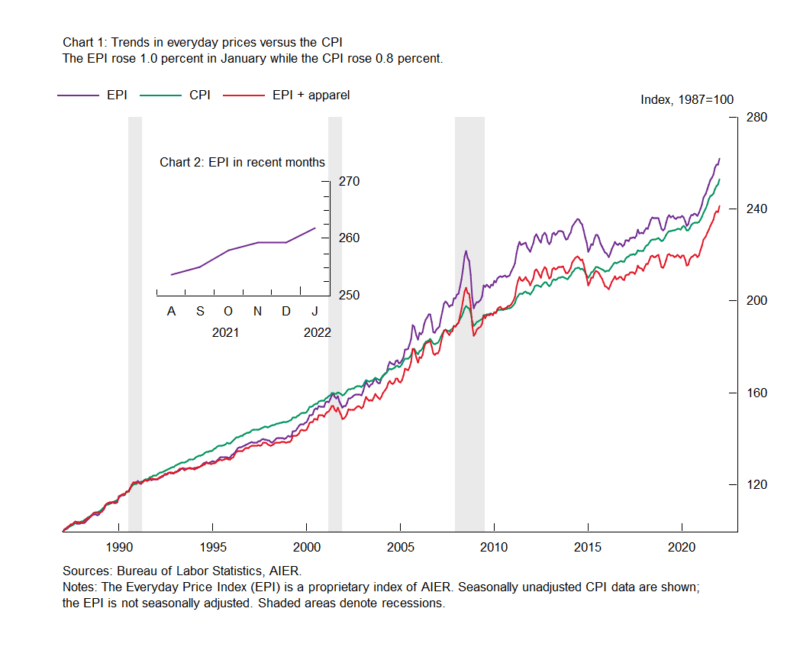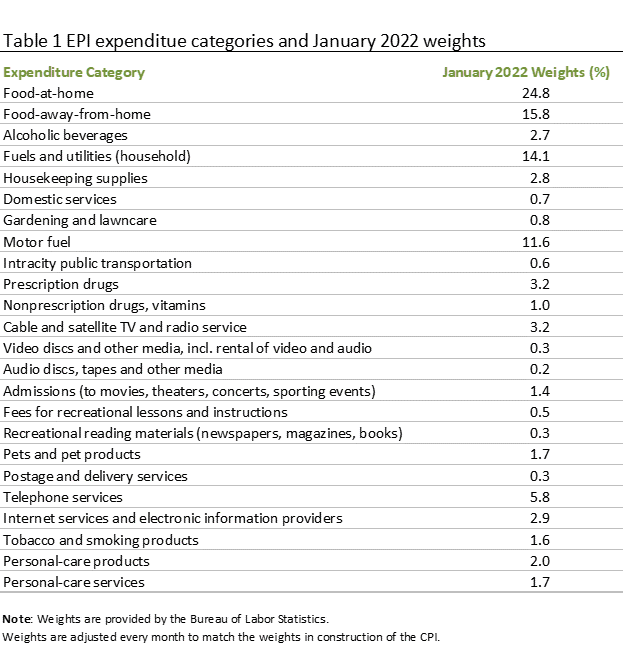AIER’s Everyday Price rose 1.0 percent in January after being unchanged in December. From a year ago, the Everyday Price Index is up 9.0 percent, above the 8.8 percent gain through December but slower than the 9.3 percent gain for the 12 months ending in November. The January 12-month gain is still among the highest ever for the Everyday Price Index.
Gains were once again broad based in January with 18 of the 24 components making a positive contribution for the month. Percent changes for the individual components ranged from a 2.9 percent increase for household fuels and utilities to a 0.7 percent decline for postage and delivery services, all on a not-seasonally-adjusted basis. The 2.9 percent rise in household fuels and utilities made it the largest contributor to the Everyday Price index, adding 38 basis points for the month. That was followed by a 26 basis point contribution from groceries (food at home) where prices rose 1.2 percent for the month, and restaurants (food away from home) which added 12 basis points to the Everyday Price Index on a 0.7 percent increase in prices. Other notable positive contributions came from housekeeping supplies, prescription drugs, and cable and satellite television and radio subscription services. Prices declines were seen in postage and delivery services, intracity transportation, nonprescription drugs, video and other media rental services, and tobacco products.
Motor fuel prices, which are often a significant driver of the monthly changes in the Everyday Price index because of the large weighting in the index and the volatility of the underlying commodity, rose just 0.1 percent for the month. Combined, food and energy categories have a weighting of 66.4 percent of the Everyday Price Index.
The Everyday Price Index including apparel, a broader measure that includes clothing and shoes, rose 1.1 percent in January after being unchanged in December. Over the past year, the Everyday Price Index including apparel is up 8.7 percent, up from 8.6 percent in December but down from a 12-month gain of 9.0 percent in November. Apparel prices rose 2.5 percent on a not-seasonally-adjusted basis in January. Apparel prices tend to be volatile on a month-to-month basis. From a year ago, apparel prices are up 5.3 percent.
The Consumer Price Index, which includes everyday purchases as well as infrequently purchased, big-ticket items and contractually fixed items, rose 0.8 percent on a not-seasonally-adjusted basis in January. Over the past year, the Consumer Price Index is up 7.5 percent, significantly less than the 9.0 percent rise in the EPI but still a multidecade high.
The Consumer Price Index excluding food and energy rose 0.7 percent for the month (not seasonally adjusted) while the 12-month change came in at 6.0 percent, also a multidecade high. The 12-month change in the core CPI was just 1.3 percent in February 2021 and 2.4 percent in February 2020, before the pandemic.
After seasonal adjustment, the CPI rose 0.6 percent in January while the core also increased 0.6 percent for the month. Within the core, core goods prices were up 1.0 percent in January and are up 11.7 percent from a year ago while core services prices were up 0.4 percent for the month and are up 4.1 percent from a year ago.
Among the notable increases in the core goods category were used cars and trucks (up 1.5 percent and 40.5 percent from a year ago), apparel (up 1.1 percent after seasonal adjustment and 5.3 percent from a year ago), furniture and bedding (up 2.4 percent and 17.0 percent from a year ago), appliances (up 1.5 percent and 8.5 percent from a year ago), tools, hardware, and outdoor equipment (up 2.2 percent and 10.7 percent from a year ago), and motor vehicle parts and equipment (up 1.7 percent and 12.6 percent from a year ago).
Among core services, gainers include owners’ equivalent rent (which accounts for 23.0 percent of the CPI, rose 0.4 percent for the month and 4.1 percent from a year ago), air fares (up 2.3 percent and 4.9 percent from a year ago), and health insurance (up 2.7 percent for the month but only 1.7 percent from a year ago). Notably, car and truck rentals, among the fastest gainers during the early part of the pandemic, were down 7.0 percent for the month, but are still up 29.3 percent for the year.
Price pressures for many goods and services in the economy remain elevated due to shortages of supplies and materials, logistical and supply chain issues, and labor problems. As activity returns to normal, supply and demand will adjust and likely lead to slower price increases, but it may take some time before the economy completely returns to normal functioning. Declining numbers of new Covid cases should help businesses reaccelerate the process, though the tight labor market will likely remain a challenge for some time.
From AIER.org
Inflation | AIER Inflation | AIER text Robert Hughes Robert Hughes



